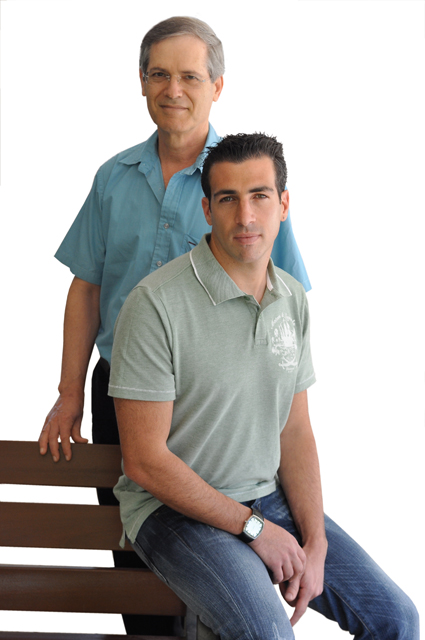The institute's scientists have discovered a number of proteins that may enable, in the future, control of the development of cancerous tumors

When cartoon characters repeatedly come back to life after a series of strange deaths - we treat it with humor. But when cancerous tumors manage to come back to life after intensive and destructive treatments - it's no longer funny at all. Scientists still do not understand how some cancer cells manage to survive chemotherapy and radiation. These resistant cells cause, in many cases, the recurrence of the disease and the death of the patient, therefore such an understanding is essential to the fight against cancer.
Prof. Menachem Rubinstein and Dr. Ofir Meir, from the department of molecular genetics at the Weizmann Institute of Science, believe that a certain cellular organelle - the endoplasmic reticulum - is involved in the matter. This is an organelle that performs many important functions in the cell - such as the production and secretion of proteins and elimination of toxins. But, just like humans who are exposed to stress, the endoplasmic reticulum also sometimes faces stress situations. These can be caused by a lack of nutrients and oxygen, or a higher than normal level of toxins. When the state of stress is temporary and mild, the endoplasmic reticulum deals with it by means of a "short vacation" from its obligations, during which it stops the production of proteins. When the state of distress lasts longer - as happens in anti-cancer treatments - the endoplasmic reticulum does not know how to deal with it, and the cell dies.
Why, then, do some cancer cells - especially those belonging to fast-growing types of cancer - not die? These tumors develop at such a high speed that the vascular system cannot keep up. As a result, the tumor cells suffer from a lack of oxygen and nutrients, and from the accumulation of toxins - all of which are supposed to cause the endoplasmic reticulum to contract, and therefore lead to the death of the cancer cell. Still, the cancer cells manage to survive. Even when the cancer cell is exposed to an all-out attack of anti-cancer treatments - most of which work by creating or increasing the constriction in the endoplasmic reticulum - it still manages to survive.
Prof. Rubinstein: "In fact, reports have been received that a state of stress in the endoplasmic reticulum actually promotes the development of the tumor - completely contrary to what was expected." Why is this happening? A hint of a possible solution to the mystery was received when scientists noticed that a certain protein, which is formed as a result of continuous stress in the endoplasmic reticulum, is found at particularly high levels in various types of cancer - such as breast, intestine, pancreas, and several rarer types of cancer. It also became clear that the protein appears in three possible types: LAP*, LAP and LIP, but the role played by the proteins LAP and LIP in determining the fate of the cell in a state of stress, and their connection to cancer, have so far remained a mystery.
To try to solve the mystery, Prof. Rubinstein and Dr. Meir changed the levels of the stress proteins LAP and LIP in groups of cells, and exposed the cells to stress states of the endoplasmic reticulum. They discovered that the cells that contained high levels of the LAP protein demonstrated a better ability to deal with the crisis, and that their mortality rate was lower. Conversely, high levels of LIP protein actually led to increased mortality, through blocking the protective activity of LAP.
To find out if these proteins play a role in cancer, the scientists measured the rate of progression of melanoma cancer in mice, under different levels of LAP and LIP. "Within just five days, the size of the tumors in the mice that contained high levels of LAP was four times larger. High levels of LIP led to the opposite phenomenon - the tumors were four times smaller," says Prof. Rubinstein.
The research findings, which were recently published in the online scientific journal PloS One, provide evidence that the protective protein LAP provides cancer cells with resistance to the stress of the endoplasmic reticulum, thus helping their survival and promoting tumor development. This conclusion is supported by additional findings that the scientists discovered about the precise role played by LAP and LIP in determining cell fate following stress caused to the endoplasmic reticulum caused by other factors. Following these findings, Prof. Rubinstein and Dr. Meir were able to identify a number of proteins controlled by LAP. It is these proteins that carry out the unwanted protection against cancer cells. These days the scientists are investigating the ways of their activity, hoping to find ways to delay it. Prof. Rubinstein: "If we succeed in finding a way to block the proteins controlled by LAP, and consequently promote the death of the cells, we may be able to eliminate the invincible resistance of cancer cells - and thus perhaps develop new and more effective treatments against cancer."
The research was carried out in collaboration with Efrat Devash, Dr. Daniela Novik, Danit Finkelstein and Sara Barak, and my research colleagues at the time, Dr. Ariel Verman and Dr. Sergey Boyanover.

3 תגובות
Can I get a link to the original article?
exciting
Only this site has such quality and in-depth articles
Well done
Is it possible to conclude that it is precisely the chemotherapy treatment that obviously creates increased stress on the cancer cell that ultimately encourages the continued development of the cancer tumor.
Beyond the fact that this treatment destroys the immune system's ability to contribute even something to fighting the tumor?